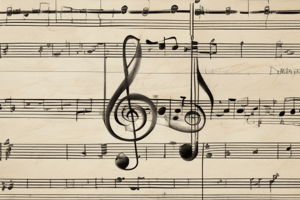Podcast
Questions and Answers
What does music theory primarily study?
What does music theory primarily study?
- The evolution of musical genres
- The practices and possibilities of music (correct)
- The history of musical instruments
- The performance techniques of musicians
Which clef is used to indicate higher pitches?
Which clef is used to indicate higher pitches?
- Treble Clef (correct)
- Bass Clef
- Alto Clef
- Tenor Clef
How many beats does a whole note represent?
How many beats does a whole note represent?
- 2 beats
- 3 beats
- 1 beat
- 4 beats (correct)
What is the pattern of a major scale?
What is the pattern of a major scale?
What type of scale consists of five notes?
What type of scale consists of five notes?
What defines a perfect interval?
What defines a perfect interval?
Which of the following is NOT a type of triad?
Which of the following is NOT a type of triad?
What does a crescendo indicate in a musical piece?
What does a crescendo indicate in a musical piece?
What is the basic unit of time in music called?
What is the basic unit of time in music called?
Which key signature indicates C Major?
Which key signature indicates C Major?
Flashcards
Music Theory
Music Theory
The study of music's practices and possibilities, including analysis of music notation.
Major Scale
Major Scale
A musical scale following a specific pattern of whole and half steps: Whole, Whole, Half, Whole, Whole, Whole, Half.
Minor Scale
Minor Scale
A musical scale with a different pattern of whole and half steps than a major scale: Whole, Half, Whole, Whole, Half, Whole, Whole.
Interval
Interval
Signup and view all the flashcards
Triad
Triad
Signup and view all the flashcards
Treble Clef
Treble Clef
Signup and view all the flashcards
Whole Note
Whole Note
Signup and view all the flashcards
Quarter Note
Quarter Note
Signup and view all the flashcards
Harmony
Harmony
Signup and view all the flashcards
Chord Progression
Chord Progression
Signup and view all the flashcards
Study Notes
Basics of Music Theory
- Definitions
- Music theory is the study of the practices and possibilities of music.
- It includes the analysis of the language and notation of music.
Notation
-
Staff
- Consists of five lines and four spaces representing different pitches.
-
Clefs
- Treble Clef: Indicates higher pitches (e.g., flute, violin).
- Bass Clef: Indicates lower pitches (e.g., cello, bass).
-
Notes
- Whole Note: 4 beats.
- Half Note: 2 beats.
- Quarter Note: 1 beat.
- Eighth Note: 1/2 beat.
-
Rests
- Indicate silence for the duration of notes.
Scales
-
Major Scale
- Pattern: Whole, Whole, Half, Whole, Whole, Whole, Half.
- Example: C Major (C, D, E, F, G, A, B).
-
Minor Scale
- Pattern: Whole, Half, Whole, Whole, Half, Whole, Whole.
- Example: A Minor (A, B, C, D, E, F, G).
-
Other Scales
- Chromatic Scale: Includes all twelve pitches.
- Pentatonic Scale: Five-note scale.
Intervals
- Definition: Distance between two pitches.
- Types:
- Perfect: Unison, Fourth, Fifth, Octave.
- Major: Second, Third.
- Minor: Second, Third (lowered).
Chords
-
Triads
- Three-note chords formed from scales.
- Types: Major (root, major third, perfect fifth), Minor (root, minor third, perfect fifth).
-
Seventh Chords
- Four-note chords combining triads with an additional interval.
- Types: Major 7, Minor 7, Dominant 7.
Harmony
- Definition: Combination of different musical notes played or sung simultaneously.
- Chords Progressions: Series of chords played in sequence (e.g., I-IV-V-I).
Rhythm
- Beat: The basic unit of time in music.
- Meter: Organization of beats into regular groups (duple, triple, and quadruple).
Dynamics
- Indicators of Volume:
- Piano (p): Soft.
- Forte (f): Loud.
- Crescendo: Gradually getting louder.
- Decrescendo: Gradually getting softer.
Form
- Structure of a piece:
- Binary: Two sections (AB).
- Ternary: Three sections (ABA).
- Sonata Form: Exposition, Development, Recapitulation.
Key Signatures
- Indicate the key of music by showing which notes are sharp or flat.
- Number of sharps/flats tells the key:
- C Major: no sharps/flats
- G Major: 1 sharp
- F Major: 1 flat.
Important Concepts
- Tonality: Centering around a specific key.
- Modulation: Changing from one key to another within a piece.
- Counterpoint: The relationship between voices that are harmonically interdependent.
Applications
- Used in composing, analyzing, and performing music across various genres.
Music Theory Basics
- Definition: Studying music's structure, principles, and possibilities.
- Covers analyzing music notation and understanding its language.
Notation
-
Staff: Five lines and four spaces representing different pitches.
- Treble Clef: Higher pitches (e.g., flute, violin).
- Bass Clef: Lower pitches (e.g., cello, bass).
-
Notes: Indicate pitch and duration:
- Whole Note: 4 beats.
- Half Note: 2 beats.
- Quarter Note: 1 beat.
- Eighth Note: 1/2 beat.
-
Rests: Indicate silence for note durations.
Scales
- Major Scale: Whole, Whole, Half, Whole, Whole, Whole, Half (e.g., C Major: C, D, E, F, G, A, B).
- Minor Scale: Whole, Half, Whole, Whole, Half, Whole, Whole (e.g., A Minor: A, B, C, D, E, F, G).
- Other Scales:
- Chromatic Scale: All twelve pitches.
- Pentatonic Scale: Five-note scale.
Intervals
- Definition: Distance between two pitches.
- Types:
- Perfect: Unison, Fourth, Fifth, Octave.
- Major: Second, Third.
- Minor: Second, Third (lowered).
Chords
-
Triads: Three-note chords built from scales:
- Major Triad: Root, Major third, Perfect fifth.
- Minor Triad: Root, Minor third, Perfect fifth.
-
Seventh Chords: Four-note chords combining triads with a seventh interval:
- Major 7th: Root, major third, perfect fifth, major seventh.
- Minor 7th: Root, minor third, perfect fifth, minor seventh.
- Dominant 7th: Root, major third, perfect fifth, minor seventh.
Harmony
- Definition: Simultaneous combination of different musical notes.
- Chord Progressions: Sequences of chords played in order (e.g., I-IV-V-I).
Rhythm
- Beat: Basic unit of time in music.
- Meter: Organizing beats into regular groups (duple, triple, quadruple).
Dynamics
- Volume Indicators:
- Piano (p): Soft.
- Forte (f): Loud.
- Crescendo: Gradually getting louder.
- Decrescendo: Gradually getting softer.
Form
- Structure of a Piece:
- Binary: Two sections (AB).
- Ternary: Three sections (ABA).
- Sonata Form: Exposition, Development, Recapitulation.
Key Signatures
- Indicates the key of a piece: Shows which notes are sharp or flat.
- Number of sharps or flats determines the key:
- C Major: No sharps or flats.
- G Major: 1 sharp.
- F Major: 1 flat.
Important Concepts
- Tonality: Centering around a specific key.
- Modulation: Changing keys within a piece.
- Counterpoint: Interdependent relationship between harmonically related voices.
Applications
- Composition: Creating new music.
- Analysis: Understanding the structure of existing music.
- Performance: Executing music with theoretical knowledge.
- Applicable across diverse musical genres.
Studying That Suits You
Use AI to generate personalized quizzes and flashcards to suit your learning preferences.




